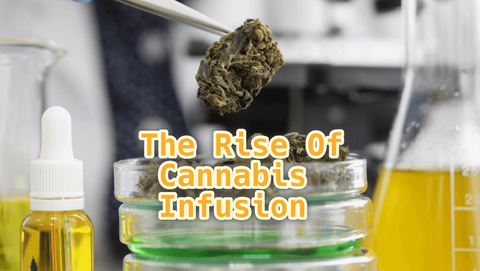Latest Blog Posts
Top rated

The Ultimate Guide To Terpenes
Terpenes, the molecules that give cannabis its characteristic flavor, smell, and other properties, are produced by the essential oil glands of many different plants. Terpenes are present in all cannabis varieties but are most active in certain strains. Certain terpenes form compounds called cannabinoids (or “potentiates”), which give a strain its distinctive aroma and taste. This is how cannabis became popular among recreational users after first becoming available for medical use.
What are Terpenes?
Imagine eating oranges and smelling the strong scent of cinnamon (obtained from cinnamon oil) to understand why people prefer to get high from cannabis. The same is true for cinnamon and orange. The scent is similar to cinnamon. This explains why people who use cinnamon as a medicine and prefer cinnamon to other medicines.
Cannabis contains terpenes, while other plants lack them altogether. So, it is not surprising that many different strains or varieties of cannabis produce different terpenes than others (even if they have similar high-cannabinoid concentrations).
Cannabis has been known to contain terpenes since pre-history, but throughout history they have been altered or suppressed so that they could be used in different ways by various cultures (notably the Chinese). Cannabis was once believed to contain no terpenes at all; however, this theory was disproved by two separate studies using modern analytical techniques: one conducted in 1982 by Jacob Schimel at the University of British Columbia and the other published in 2000 by Professor David E. Abrams at King’s College London.
The research showed that THC-enriched cannabis contains more than 80% of total chemical constituents from cannabinoids and terpenoids (the latter being chemicals found only in some plants), with less than 5% coming from cannabinoids alone. These include alpha-pinene (pinene), beta-caryophyllene, myrcene, lavender oil, and limonene.
Many people have heard about the cannabinoid cannabidiol or CBD. Still, they are not aware that there is another type of cannabinoid called cannabigerol or CBG – also known as THCV or tetrahydrocannabinolic acid – which has been shown to bind to receptors within human brains much like CBD does. That's why it is said to have “entourage effects,” meaning it helps out its parent compound.
What Do Terpenes Do in Cannabis?
Terpenes are the aromatic oils found in all plants. These molecules are responsible for the distinct smell and taste of cannabis varieties and have an important role in the plant’s effects. Cannabis has been used for at least 7,000 years, with scientific findings dating back to the Roman Empire. In recent years, terpenes have gained increased attention as they hold a variety of potential therapeutic applications.
Pinene is a sweet, fruity-green oil that gives cannabis strains their distinctive smell and is also known for being an important component of the terpenes. It is also often found in floral mixtures like balsam and geranium.
Terpenes and the Entourage Effect
The entourage effect refers to their relationship with other molecules present in a plant’s essential oil that affect its results. Ocimene is a terpene found in most cannabis strains and is synergistic with THC and CBD. It has also been shown to have anti-inflammatory properties and anti-cancer properties.
In addition, ocimene is also known to inhibit carcinogen metabolism. It may help prevent cancer development by suppressing the activity of enzymes responsible for this process. Terpene provides multiple benefits for those looking for relief from chronic pain, anxiety and depression; however, Ocimenes are generally not included in standard cannabis strains.
The Benefits of Terpenes
Terpenes are aromatic compounds produced by plants, which play a significant role in the smell and taste of cannabis varieties. Terpenes are commonly known as “aromatic oils”, but they aren’t oily liquids. The active molecules that make up terpenes are water-soluble compounds, and they can be broken down into simpler compounds like benzene, but that is not how they are usually perceived.
The molecules that make up terpenes vary from plant to plant. It is not entirely clear how much of them are present in any given strain — though there may be enough to make their presence detectable through the smell of the cannabis itself (and with some strains, particularly Indica-dominant strains, terpenes can also be detected with analytical equipment).
For example:
1) Cannabis sativa contains over 400 different terpene compounds
2) Indica is the predominant type of Sativa found in modern strains (indoor/greenhouse varieties)
3) Sativa is generally high in valerianic acid (an aroma compound), while hybrid varieties tend to have more limonene-type compounds (particularly limonene)
4) Some Indica strains contain higher levels of thujone (another aroma compound), while some Sativa strains have lesser.
5) Even though numerous different types of terpenes are present in cannabis, most are relatively similar to one another. So, what makes certain terpene compounds more potent than others?
How to Use Terpenes
Terpenes are a group of naturally occurring compounds frequently found in many plants. They can be extracted from the plant material or synthesized in a laboratory. Terpenes are responsible for the distinctive taste and smell of cannabis varieties and have an important role in the plant’s effects.
Cannabis cultivators often use terpenes to increase the terpene content of their growing mediums and help maintain their products' terpene profile. Producing terpenes involves two basic steps: extracting them from the plant material and then purifying them to be used as components in commercial products.
The first step consists of isolating terpenes from whole plant material that has been harvested and dried, such as leaves or buds, or from synthetic materials such as oils produced through chemical synthesis processes, such as essential oils.
The second step is purification which involves reducing complex compounds formed when terpenes interact with other chemicals to form compounds with more specific characteristics, such as carvacrol (which is responsible for cedarwood’s aroma) being separated from the essential oil (which comes from the flowers). Commercial use of these terpenes requires their synthetic production and detailed knowledge of their structure and metabolism.
The Future of Terpenes
In recent years, terpenes have been gaining more attention as a target of research and development in chemical biology. Terpenes are very similar in structure to cannabinoids (such as THC or CBD), with which they share several similarities. However, little is known about how terpenes work within a plant, so the future of terpenes research is still uncertain.
The role that terpenes play has yet to be fully understood. Terpenes can become activated by heat and light, but this activation is not uniform across different strains. Some contain terpene precursors, and others do not.
Much work has focused on characterizing these precursors (including their chemical structures) rather than understanding how they function within plants or the human body. The most recent study was published by scientists from UC Davis. They identified 471 unique terpene precursors within cannabis plants — making it one of the largest terpene libraries ever assembled for a single species.
Importantly, many of these precursors were highly active at eliciting physiological responses like photosynthesis and growth. This work provides an important piece of information about how terpene precursors function in plants and human health — but future studies can uncover even more details remains to be seen.
Disclaimer: This material is for informational purposes only and should not be relied on for legal, medical, financial, or any other form of professional advice.















